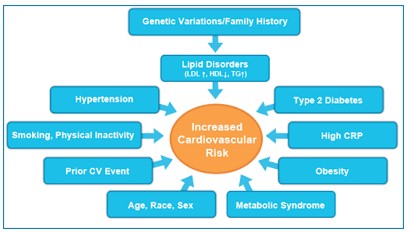A Quandary Standpoint of Ayurveda on Diabetes with associated CVDs
DOI:
https://doi.org/10.21760/jaims.9.3.31Keywords:
Cardiovascular risk factors, Diabetes mellitus, Heart care, AyurvedaAbstract
Cardiovascular disease (CVD) in persons with diabetes has a significant and growing impact on public health. Patients diagnosed with diabetes mellitus type I or type II are highly susceptible to many heart conditions, including congestive heart failure, peripheral arterial disease, cardiomyopathy, and coronary heart disease. Diabetes demands rigorous control of all cardiovascular risk factors due to its significant risk of cardiovascular morbidity and mortality. According to estimates, the global population with diabetes will increase from 171 million in 2000 to 366 million by 2030, and the global population with hypertension will rise by 60% to reach 1.56 billion by 2025. 65–75% of deaths among diabetics are attributable to cardiovascular disease. The rationale is that cardiovascular illnesses and diabetes mellitus share a number of risk factors. The current medical system is effective in preventing infectious diseases, but it has not been effective in preventing diseases linked to a lifestyle by itself. Ayurvedic medicine is the best at managing and preventing lifestyle problems since it emphasizes a complete lifestyle adjustment for the patient. For those with diabetes and CVD, a special regimen of food (Aahar), exercise (Vihar), and herbs (Aushadhi) can help reduce symptoms and promote overall health. Reviewing the co-morbidity between diabetes mellitus (Madhumeha) and its related cardiovascular risks is the goal of this research work.
Downloads
References
Mary Grace Tungdim, T. Ginzaniang, G. Poufullung Kabui, Deepali Verma, and Satwanti Kapoor, Risk of Cardiovascular Disease among Diabetic Patients in Manipur, Northeast India, Journal of Anthropology, Volume 2014, Article ID 421439, 9 pages.
Soni Anamika & Soni Surendra, CARDIAC DISEASES AND AYURVEDA- A REVIEW, IAMJ: Volume 3; Issue 1; January – 2015.
A.P.I (Associations of Physicians in India), Textbook of Medicine, 6th edition, pp.383- 394, Mumbai, India.
Amgad N. et al, Coronary artery diameter as risk factor for Acute Coronary Syndromes in Asian Indians, American J of Cardiology, 2005; 96(6): 15.
Shukla N (2012) Management of Cardiac Emergencies in Ayurveda – A Clinico-literary Approach. 1: 203. doi:10.4172/scientificreports.203.
Lonn, E, Yusuf S, Arnold MJ, Sheridan P, Pogue J, et al. (2006) Homocysteine Lowering with Folic Acid and B Vitamins in Vascular Disease. N Engl J Med 354: 1567-1577.
Diabetes Statistics. National Diabetes Information Clearinghouse. Bethesda, Md: National Institute of Diabetes and Digestive and Kidney Diseases, NIH publication, 1999; 99-3926.
Clinical Guidelines on the Identification, Evaluation and Treatment of Overweight and Obesity in Adults: the Evidence Report. Bethesda, Md: National Institutes of Health, National Heart, Lung and Blood Institute 1998.
US Department of Health and Human Services. Physical Activity and Health: A Report of the Surgeon General. Atlanta, Ga: US Department of Health and Human Services; Centers for Disease Control and Prevention; National Center for Chronic Disease Prevention and Health Promotion; 1996.
UK Prospective Diabetes Study (UKPDS) Group. Intensive bloodglucose control with sulphonylureas or insulin compared with conventional treatment and risk of complications in patients with type 2 diabetes (UKPDS 33). Lancet. 1998; 352: 837– 853.
International Diabetes Federation 2011. The Global Burden Prevalence and Projections 2011 and 2030. Available from: http: //www.idf.org/diabetesatlas/5e/theglobalburden.
Tiwari, A. K., Imbalance in antioxidant defense and human diseases: Multiple approach of natural antioxidants therapy. Curr. Sci., 2001; 81: 1179–1187.
Mohan, V., Shanthirani, C. S. and Deepa, R., Glucose intolerance (diabetes and IGT) in a selected south Indian population with special reference to family history, obesity and lifestyle factors – The Chennai Urban Population Study (CUPS 14). J. Assoc. Physicians India, 2003; 51: 771–777.
Mohan, V., Shanthirani, C. S. and Deepa, R., Glucose intolerance (diabetes and IGT) in a selected south Indian population with special reference to family history, obesity and lifestyle factors – The Chennai Urban Population Study (CUPS 14). J. Assoc. Physicians India, 2003; 51: 771–777.
Ramachandran, A. et al., For the Diabetes Epidemiology Study Group in India (DESI). High prevalence of diabetes and impaired glucose tolerance in India; National Urban Diabetes Survey. Diabetologia, 2001; 44: 1094–1101.
Shukla N (2012) Management of Cardiac Emergencies in Ayurveda – A Clinico-literary Approach. 1: 203. doi:10.4172/scientificreports.203.
Bonaa KH, Njolstad I, Ueland PM, Schirmer H, Tverdal A, et al. (2006) Homocysteine Lowering and Cardiovascular Events after Acute Myocardial Infarction. N Engl J Med 354: 1578.
Ashok K. Tiwari Wisdom of Ayurveda in perceiving diabetes: Enigma of therapeutic recognition, Current Science, Vol. 88, No. 7, 10 April 2005.
Nature Clinical Practice Endocrinology and Metabolism (2007) Vol. 3, 667 doi: 10.1038/ncpendmet0638 downloaded from www.nature .com on 1st July 2013.
Sharma A.K., Heart disorders and their care in Ayurveda, 1st Edition Satguru Publications, 2005.
Sharma R. H, Heart diseases and Ayurveda, 1st Edition, Satguru Publications, 2012.
Athavale V.B, Cardiology in Ayurveda, 1st Edition, Chaukhamba Sanskrit Pratishthan, N. Delhi, 1999.
R. Javalgekar Ravi, The Yoga Science, 1st Edition, Chaukhamba Sanskrit Pratishthan, N. Delhi. 2005.















